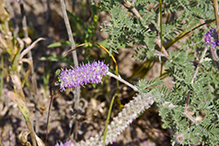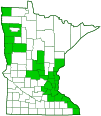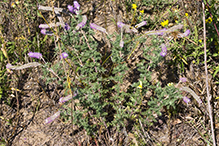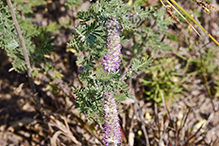silky prairie clover
(Dalea villosa var. villosa)
Conservation • Description • Habitat • Ecology • Use • Distribution • Taxonomy
Conservation Status |
|
|||||||
| IUCN Red List | not listed |
|||||||
| NatureServe | NNR - Unranked SNR - Unranked |
|||||||
| Minnesota | not listed |
|||||||
Description |
||
Silky prairie clover is a 8″ to 20″ tall, bushy, perennial forb that rises on one to several stems from a stout, woody taproot and caudex. The stems ascending or reclining on the ground with just the tips ascending. They are branched at the base and are densely covered with long, soft, shaggy, unmatted hairs. The leaves are alternate, numerous, crowded, 1 3 ⁄16″ to 2⅜″ long, ½″ to 1″ wide, and on short stalks. They are pinnately divided into 9 to 21 leaflets, usually 11 to 17, always an odd number. There are often tight bundles of leaves in the leaf axils. At the base of the leaf stalk there is a pair of awl-shaped, leaf-like appendages (stipules). The leaflets are closely spaces, narrowly elliptic or inversely lance-shaped, often more or less folded, 3 ⁄16″ to ⅜″ long, and 1 ⁄16″ to ⅛″ wide. The end leaflet is smaller than the two adjacent lateral leaflets. The upper and lower surfaces are densely covered with long, soft, shaggy, unmatted hairs. The margins are untoothed. The inflorescence is a dense, cylinder-shaped spike of flowers at the end of each stem. When in fruit the spike is ¾″ to 4″ long and about 5 ⁄16″ wide. The flowers at the base of the spike bloom first, progressing toward the tip, but more than half of the spike is in blossom at any one time. It often appears that the entire head is in flower at once. The calyx is ⅛″ to 3 ⁄16″ long, 10-ribbed, and densely covered with long, soft, shaggy, unmatted hairs. The flowers are about ¼″ long and about ¼″ wide, numerous, and pale rose-purple, rarely white. There have 5 white, long-clawed petals. The petals do not form the typical banner, wings and keel of most plants in the Pea family. Instead, there is a banner petal and four other petals fused at least part way with the 5 stamen bases and 4 staminodes into a floral tube. The fruit is an oval pod about ⅛″ long with 1 seed. |
||
Height |
||
8″ to 20″ |
||
Flower Color |
||
Pale rose-purple |
||
Similar Species |
||
Purple prairie clover (Dalea purpurea var. purpurea) stems, leaves, and calyces are hairless or sparsely hairy. The leaves have only 3 to 7, usually 5, leaflets. The leaflets are linear, not elliptic or lance-shaped. The flowering spike is no more than 2¾″ long. White prairie clover (Dalea candida var. candida) stems, leaves, and calyces are hairless. The leaves have only 5 to 9, usually 7, leaflets. The flowering spike is no more than 2⅓″ long. The flowers are white. |
||
Habitat |
||
Dry. Sandy prairies. Full sun. |
||
Ecology |
||
Flowering |
||
July to August |
||
Pests and Diseases |
||
|
||
Use |
||
|
||
Distribution |
||||
|
Sources |
|||
| 6/1/2023 | ||||
Nativity |
||||
Native |
||||
Occurrence |
||||
|
||||
Taxonomy |
|||
| Kingdom | Plantae (Plants) | ||
| Division | Tracheophyta (Vascular Plants) | ||
| Subdivision | Spermatophytina (Seed Plants) | ||
| Class | Magnoliopsida (Dicots) | ||
Order |
Fabales (Legumes, Milkworts, and Allies) | ||
Family |
Fabaceae (Legumes) | ||
| Subfamily | Faboideae | ||
| Tribe | Amorpheae | ||
Genus |
Dalea (prairie clovers) | ||
| Species | Dalea villosa (silky prairie clover) | ||
Subordinate Taxa |
|||
Synonyms |
|||
| Petalostemon villosus | |||
Common Names |
|||
downy prairie-clover hairy prairie-clover silky prairie clover silky prairie-clover silky prairieclover |
|||
Glossary
Calyx
The group of outer floral leaves (sepals) below the petals, occasionally forming a tube.
Caudex
A short, thickened, woody, persistent enlargement of the stem, at or below ground level, used for water storage.
Pinnate
On a compound leaf, having the leaflets arranged on opposite sides of a common stalk. On a bryophyte, having branches evenly arranged on opposite sides of a stem.
Staminode
A modified stamen that produces no pollen. It often has no anther.
Stipule
A small, leaf-like, scale-like, glandular, or rarely spiny appendage found at the base of a leaf stalk, usually occurring in pairs and usually dropping soon.

Slideshows |
||

Visitor Videos |
|||
Share your video of this plant. |
|||
| This button not working for you? Simply email us at info@MinnesotaSeasons.com. Attach a video, a YouTube link, or a cloud storage link. |
|||
Other Videos |
|||

Visitor Sightings |
|||||
Report a sighting of this plant. |
|||||
| This button not working for you? Simply email us at info@MinnesotaSeasons.com. Be sure to include a location. |
|||||
|
|||||
MinnesotaSeasons.com Sightings |
|||||

|
Created: Last Updated: © MinnesotaSeasons.com. All rights reserved. |



